Aero Chocolate: All You Need to Know About this Chocolate Bar
Aero chocolate, which is renowned for its distinctive bubbly texture, is an aerated chocolate bar (i.e., chocolate with air bubbles in it) first introduced to the world in 1935. The company responsible for this invention was called Rowntree’s out of North of England, and they called it “new chocolate”. In the first year after this chocolate bar was launched, the demand grew across the UK, and sales accelerated beyond expectations.
Soon enough, the “New Chocolate” reached New York City, marking the beginning of its international journey in 1936. In 1988, Rowntree’s was acquired by Nestlé, a Swiss multinational corporation, becoming Nestlé UK. Over time, the Aero brand made its way to numerous other countries, such as Canada, Australia, South Africa and Japan. Nowadays, “Aero” offers a wide range of flavours and dessert variations across the globe.
In this blog post, we will explore the fascinating world of Aero, uncovering aired chocolate’s history, indulge in its unique texture, and discover the array of flavours that the bubbly sensation has to offer.
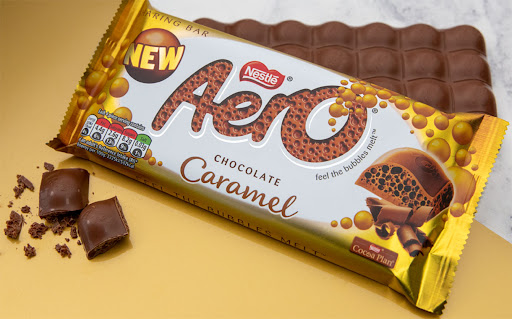 Aero Chocolate Caramel Sharing Bar (FoodBev)
Aero Chocolate Caramel Sharing Bar (FoodBev)
What Is the Aero Chocolate?
It is an aerated, aired, or simply air chocolate bar that is created by the addition of bubbles to the chocolate. The Aero chocolate bar is rectangular in shape with a smooth, shiny surface. The chocolate shell is thin, and when you break it apart, you can see tiny bubbles on the inside that give it a light structure. It melts instantly on your tongue and has a creamy feel. The taste is rich, and the bubbles create a delightful sensation with each bite.
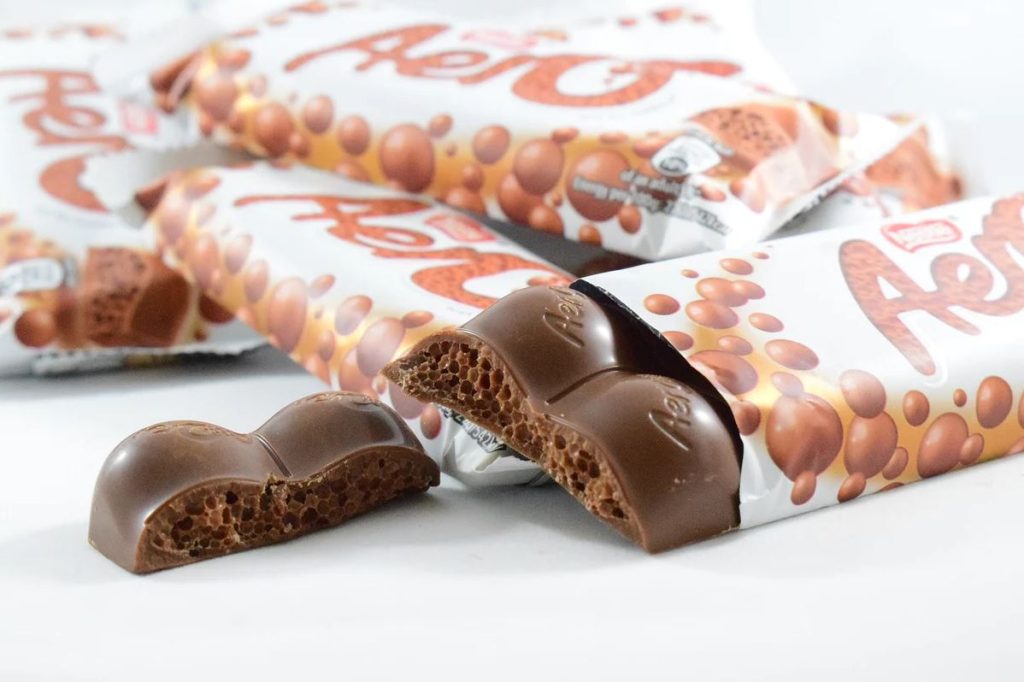
Aero Milk Chocolate Bar (British aisles)
What’s Special About the Aero Chocolate Bar?
In general, Aero chocolates have:
- faster melting experience
- lighter weight
- bubbly structure
- less calory per portion
- more intense flavour experience
Aerated chocolate bars melt faster than regular chocolate because of the many tiny pockets within their foamy texture. Moreover, based on research, those tiny bubbles can lead to a more intense flavour experience.
With such an effect on the taste and feel of the product, controlling the bubble size and their even distribution across the chocolate would be an important factor. Efforts to better control the bubbles have even led to experiments under zero-gravity conditions.
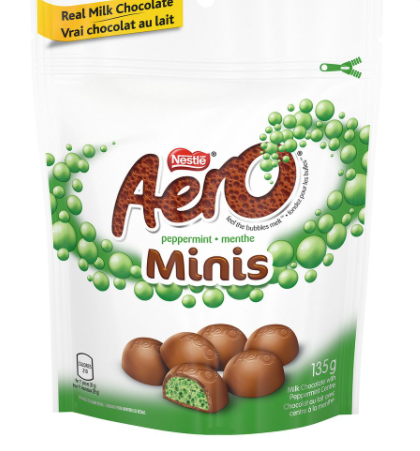 Aero Peppermint Milk Chocolate Minis (Loblaws)
Aero Peppermint Milk Chocolate Minis (Loblaws)
Aero Chocolate Bar Flavours
Aero bars come in various flavours. Thus, if you are a fan of the bubble experience, there are an array of options to choose from. Let’s explore the regular, the specials, and the seasonal variations.
Regular flavours (in Canada) include:
- Milk Chocolate (original)
- Peppermint Chocolate (Green, bubbly, mint-flavoured centre, covered in milk chocolate)
- Orange Chocolate
- Dark Chocolate (70% dark chocolate)
- Dark and Milk Chocolate
- Truffle Brownie
- White (milk chocolate outer and a white bubbly centre)
- Tiramisu Milk Chocolate
- Truffle Chocolate Mousse Milk Chocolate
- Truffle Nanaimo Bar
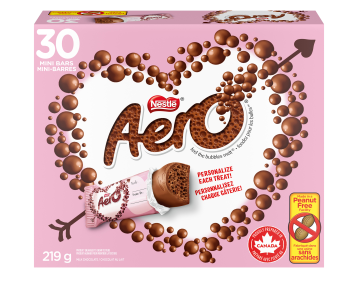 Aero Valentine’s Minis 30-pack (Nestlé Canada)
Aero Valentine’s Minis 30-pack (Nestlé Canada)
In addition to these, there are certain flavours that are only available for special occasions, including Valentine’s, Easter, Christmas, and Halloween.

Aero Truffle Tiramisu Ice Cream
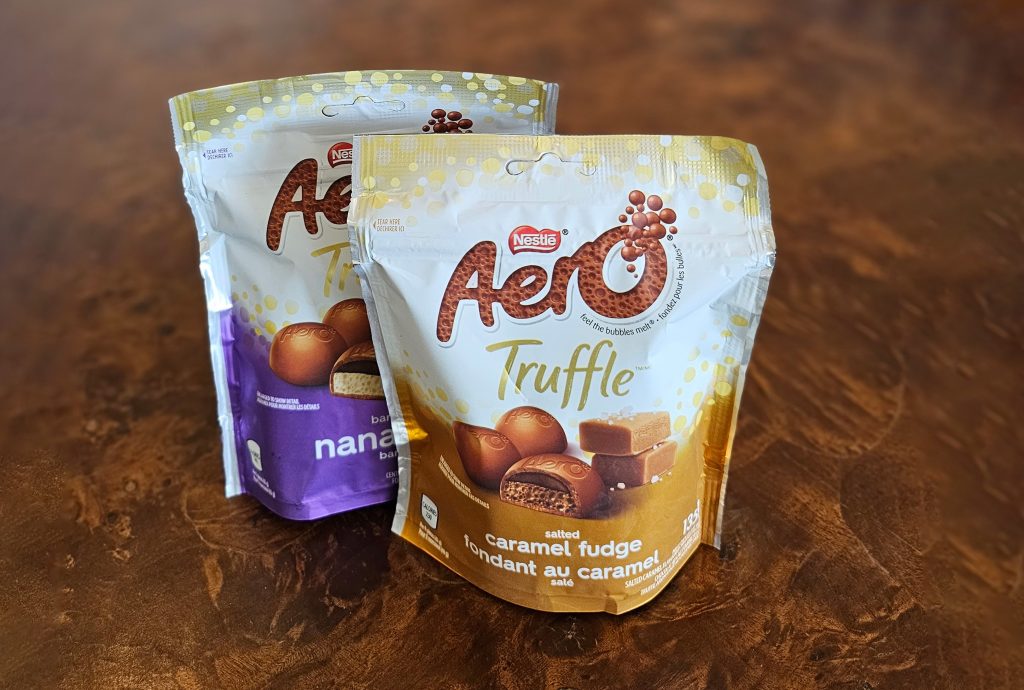
Salted Caramel Fudge and Nanaimo Aero
The Aero bubble sensation has been extended to other confectioneries and dessert products as well. Some of these products include Aero Biscuits, Aero Mousse, Aero Drinks, and Aero Ice Cream.
 Rowntree’s Factory in York (York’s chocolate story)
Rowntree’s Factory in York (York’s chocolate story)
Earlier Steps of Aero
The manufacturing process for aired chocolate was patented by Rowntree’s. While the company’s name might not ring a bell, it has crafted some of the most iconic treats we know today, such as Fruit Pastilles (1881), Kit Kat (1935), Smarties (1937), Rolo (1937), and After Eight (1962).
In recognition of its outstanding contribution to international trade, Rowntree’s received the prestigious Queen’s Award for Enterprise in 1981. By the time Nestlé acquired the company, it had secured its position as the fourth-largest confectionery manufacturer worldwide.
Now, let’s get to the bubbles.
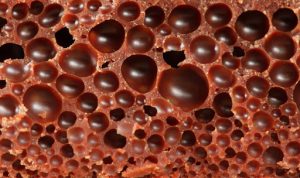 Aerated Chocolate Bubbles (new food magazine)
Aerated Chocolate Bubbles (new food magazine)
What’s Inside the Bubbles?
The bubbly texture cannot be created by simply injecting air into the chocolate as the oxygen speeds up the rancidification of the chocolate. Rancidification usually occurs when food with a lot of fat in it is exposed to things like air, heat, or light for too long, making it taste yucky and not good to eat. To avoid that, nitrogen, argon, carbon dioxide, and nitrous oxide can be used instead.
Carbon dioxide and nitrous oxide result in a more bubbly structure, while argon and nitrogen can result in smaller bubbles. A sensory study shows that chocolates made with the latter are perceived to be harder, less aerated, slower to melt in the mouth, and have a higher overall flavour intensity in comparison with the other group.
How Are the Bubbles Created in the Chocolate?
Aeration in chocolate has been a common commercial practice since Rowntree’s patented the technique. Over time, various methods have been developed to introduce bubbles into the chocolate.
Pretty much in most of them, the melted chocolate is first turned into a foamy texture with the help of a propellant. Then, the foam is cooled down in a lower-pressure environment, allowing the bubbles to expand before the chocolate solidifies.
The process of aeration enables chocolate products to have a lighter weight in relation to their volume, resulting in reduced calories per portion in addition to a distinctive texture that helps make the overall experience different.
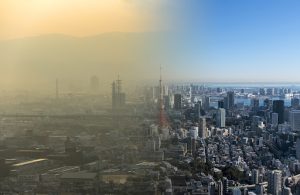 Clear vs. Polluted Tokyo Sky (Japan Times)
Clear vs. Polluted Tokyo Sky (Japan Times)
From Air Chocolate to the Air We Breathe
Now that we know how different gases can produce different qualities in chocolates, let’s take a look at the air we breathe and see how it affects our lives. The air in the Earth’s atmosphere is made up of a mixture of different gases: approximately 78% nitrogen, 21% oxygen, and 1% other gases such as carbon dioxide, neon, hydrogen, argon, neon, helium, nitrous oxide, etc.
When we breathe, the air we exhale is similar to the air we inhale in composition, with only the levels of carbon dioxide and oxygen changing. The air we inhale contains approximately 78% nitrogen, 21% oxygen, and 0.04% carbon dioxide, whereas the air we exhale contains about 78% nitrogen, 17% oxygen, and 4% carbon dioxide.
| Air Composition | Nitrogen | Oxygen | Carbon Dioxide | Other |
| Inhale | 78% | 21% | 0.04% | ~1% |
| Exhale | 78% | 17% | 4% | 1% |
Air can also carry other things, such as water, living organisms, pollen, and tiny particles that can cause pollution, such as smoke, dust, and acidic droplets. It can be difficult for humans, animals, and plants to breathe when there are too many of these particles in the air. Factors that contribute to poor air quality include forest fires and heavy traffic in cities.
The Air Quality Health Index, or “AQHI,” is a scale designed to measure air pollution in relation to our health from 1 to 10. The lower the AQHI, the cleaner the air. However, when the amount of pollution is very high, the index will report 10+. The AQHI gives you this information along with some suggestions on how you can adjust your activity based on your individual health risk against air pollution. Find your local AQHI score in your community.
Wrap-up
The aero chocolate bar has undeniably left a bubbly mark on the confectionery world since its initial release. The iconic Aero bubbles and the combination of mint and milk chocolate have managed to capture the hearts and taste buds of consumers for several generations. With each new product unveiled, Aero continues to prove its status as a beloved treat on different occasions.




